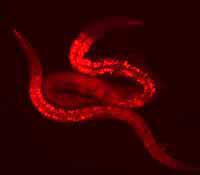Opposing fat metabolism pathways triggered by a single gene

Regulation of b-oxidation gene expression by nhr-49. Photo: Keith Yamamoto et al.
Regulating metabolism of fat is an important challenge for any animal, from nematodes to humans. Central players in the regulatory network are the nuclear hormone receptors (NHRs), which are transcription factors that turn on or off a set of target genes when bound by specific lipid molecules. In the premier open-access journal PLoS Biology, Keith Yamamoto and colleagues show that the nuclear hormone receptor nhr-49 controls two different aspects of fat metabolism, which interact to form a feedback system controlling the consumption and composition of fats in the nematode.
Using RNAi to suppress gene expression, the researchers discovered that when nhr-49 was absent, the lifespan of the nematode was reduced by more than 50%, and the animal displayed numerous gross abnormalities in the gut and gonad. This was accompanied by unusually high fat content in the larvae. They further showed that deletion of nhr-49 changed expression of 13 genes related to fat and glucose metabolism, with the most dramatic effects occurring within two metabolic pathways: mitochondrial lipid oxidation and fatty acid desaturation.
Following up on these changes in gene expression, Yamamoto and colleagues show that in its normal actions, nhr-49 sets in motion two opposing pathways: it increases expression of a gene acs-2, which leads to reduction of fat content, and it increases expression of another gene fat-7, which, by reducing acs-2, increases fat content. In its function, nhr-49 resembles a mammalian NHR, called peroxisome proliferator-activated receptors (PPARs). Further investigation of this link may lead to better understanding of the functions of PPARs and provide opportunities for altering their function for treatment of fat metabolism disorders such as diabetes and obesity.
Media Contact
All latest news from the category: Life Sciences and Chemistry
Articles and reports from the Life Sciences and chemistry area deal with applied and basic research into modern biology, chemistry and human medicine.
Valuable information can be found on a range of life sciences fields including bacteriology, biochemistry, bionics, bioinformatics, biophysics, biotechnology, genetics, geobotany, human biology, marine biology, microbiology, molecular biology, cellular biology, zoology, bioinorganic chemistry, microchemistry and environmental chemistry.
Newest articles

Sea slugs inspire highly stretchable biomedical sensor
USC Viterbi School of Engineering researcher Hangbo Zhao presents findings on highly stretchable and customizable microneedles for application in fields including neuroscience, tissue engineering, and wearable bioelectronics. The revolution in…

Twisting and binding matter waves with photons in a cavity
Precisely measuring the energy states of individual atoms has been a historical challenge for physicists due to atomic recoil. When an atom interacts with a photon, the atom “recoils” in…

Nanotubes, nanoparticles, and antibodies detect tiny amounts of fentanyl
New sensor is six orders of magnitude more sensitive than the next best thing. A research team at Pitt led by Alexander Star, a chemistry professor in the Kenneth P. Dietrich…





















